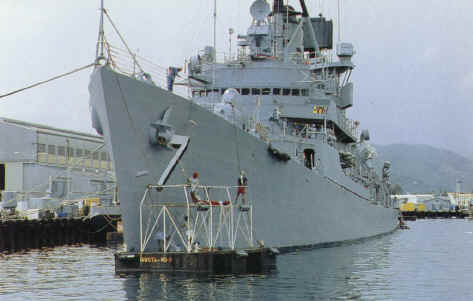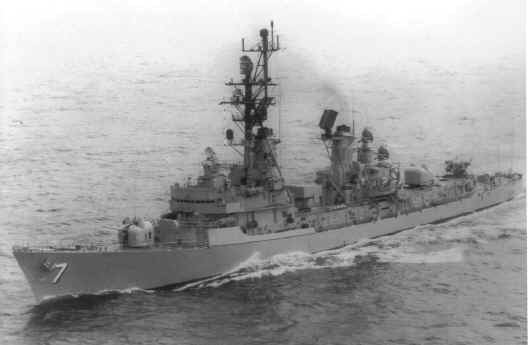|

THE BEARING RACE
By Bob Cohen, Ensign, Boilers Officer
USS HENRY B. WILSON (DDG-7)
 The hotter you boiled the water, and the
higher the pressures you kept it bottled up at, the more energy you'd be
able to extract when the steam hit the turbine blades. In other words, you’d get
more shaft-horsepower for each gallon of fuel burned. Theoretically, this
increase in efficiency would continue until something known as the ‘end-point’
was reached at around thirty-two hundred pounds per square inch.
The Navy never did make it to the end point – at twelve hundred pounds
and one thousand degrees, things started to happen…
The hotter you boiled the water, and the
higher the pressures you kept it bottled up at, the more energy you'd be
able to extract when the steam hit the turbine blades. In other words, you’d get
more shaft-horsepower for each gallon of fuel burned. Theoretically, this
increase in efficiency would continue until something known as the ‘end-point’
was reached at around thirty-two hundred pounds per square inch.
The Navy never did make it to the end point – at twelve hundred pounds
and one thousand degrees, things started to happen…
“We broke the grasshopper on two-alfa boiler!”
I couldn’t believe it. How did these guys manage to break that? The
'grasshopper' was a huge scissors mechanism that served to force the main steam
stop-valve closed against the enormous pressure of the 1200-psi boiler. In
reality, it was nothing more than a big sideways automobile jack – there weren’t
exactly a lot of things that could go wrong with a grasshopper. However, as
boilers officer of the USS Henry B. Wilson, I was kinda used to the idea that if
you gave my BTs a bowling ball they’d figure out a way to disassemble it into
pieces. Unfortunately, I was also used to the idea that the chief
engineer, all five feet of him, would then scream at me until he lost his voice.
It turned out to be less serious than I had
feared. They didn’t actually break the whole grasshopper, just a small
and simple piece of it. At each end of the shaft that operated the scissors that
actually closed the valve, were the customary thrust bearings. The bearing
assemblies consisted of two flat circular steel rings, each with a shallow
groove around its circumference on one side, with a bunch of ball bearings
racing around, sandwiched in the grooves between the two rings. I guess that’s
why the ring was called a ‘bearing race.’ In any case, that’s what they broke –
just a simple steel ring. The only thing separating it from an ordinary washer
was that groove on one side. That, and the fact that without it, one of my
boilers was off the line. Of course, we didn’t have any spares. Nobody ever
broke one before.
 In the early eighties the Navy was using a system of readiness
reporting in which everything was classified ‘C-1’ (fully combat-ready)
through ‘C-4’ (welded to the pier). One of the principles of that particular
system was that you couldn’t be any more ready overall than your least ready
area. In other words, even if all your gear worked and your people were trained
and chomping at the bit, if you had no food on board you were ‘C-4’ for supplies
no matter good you were otherwise. Also, your readiness status (and any changes
to it) was broadcast by radio for instant reference on that big status-board at
the Pentagon. With only three out of four boilers available, we
had to send out an embarrassing radio message reporting our little engineering
casualty, thereby changing our overall number for the worse. Not that the
captain would care, he was a real easygoing guy. And if my grandmother had
wheels, she’d be a truck.
In the early eighties the Navy was using a system of readiness
reporting in which everything was classified ‘C-1’ (fully combat-ready)
through ‘C-4’ (welded to the pier). One of the principles of that particular
system was that you couldn’t be any more ready overall than your least ready
area. In other words, even if all your gear worked and your people were trained
and chomping at the bit, if you had no food on board you were ‘C-4’ for supplies
no matter good you were otherwise. Also, your readiness status (and any changes
to it) was broadcast by radio for instant reference on that big status-board at
the Pentagon. With only three out of four boilers available, we
had to send out an embarrassing radio message reporting our little engineering
casualty, thereby changing our overall number for the worse. Not that the
captain would care, he was a real easygoing guy. And if my grandmother had
wheels, she’d be a truck.
Everybody’s mad at me like we broke this
stupid thing on purpose. We pull into San Diego, and I learn that the
DESRON staff has located our obscure part at some supply depot near Long Beach.
I call the phone number the squadron provided, and after a few runarounds I
finally get the right guy on the line. “So, you got that bearing race in stock?”
“Yeah, we got it.”
“Great! When can I get it?”
“You can’t get it.” Long pause. I thought he was kidding. “What do you mean, I
can’t get it?”
“It’s a nuclear part.” When the Navy first built their 1200-pound plants in the
late fifties, they used the same level of quality assurance as was used in the
nuclear plants of the era. As we gained experience and confidence in the new
high-pressure plants, they down-rated the associated QA levels of the various
parts. Apparently, nobody else had ever broken one of these bearing races
either, because nobody ever thought to down-rate them and take them off the
nuclear list. “Listen, I don’t think you understand. We’re not a nuclear ship.”
“No, Mister, I don’t think you understand. I know you’re not a nuclear ship.
That’s why you can’t have it.”
 I was sitting in the wardroom, despondent over the thought of
having to listen to that malignant dwarf scream at me, when I absently
looked at the broken piece of metal in my pocket. On one side, I could just
barely make out the worn stamp: “Acme Hardware Inc., San Diego, Calif.” With
nothing to lose, I dialed information for the number. “There really is an Acme
Hardware Company?”
I was sitting in the wardroom, despondent over the thought of
having to listen to that malignant dwarf scream at me, when I absently
looked at the broken piece of metal in my pocket. On one side, I could just
barely make out the worn stamp: “Acme Hardware Inc., San Diego, Calif.” With
nothing to lose, I dialed information for the number. “There really is an Acme
Hardware Company?”
The guy on the phone was almost bored. “Yeah, we got it.
That’s $12.95 each. How many you need?” He was puzzled by my enthusiasm as I
said, “Just one!” I grabbed BT3 Smith, stuffed a $20 in his hand and told him to
hurry. And I wanted my change. He came back about an hour later with a
brand-new, bright, shiny washer – with a groove around the circumference on one
side.
The new part fit perfectly, and the legs of the
grasshopper flexed their muscles effortlessly. Two-Alfa was back on the line. I
was ready to head for the Mainbrace to pound down a few beers when someone
pointed out that without the Navy stock numbers and the requisition information,
we wouldn’t be able to send out the radio message to upgrade our status on
the big board. I could hear the screaming starting again…

 

|
